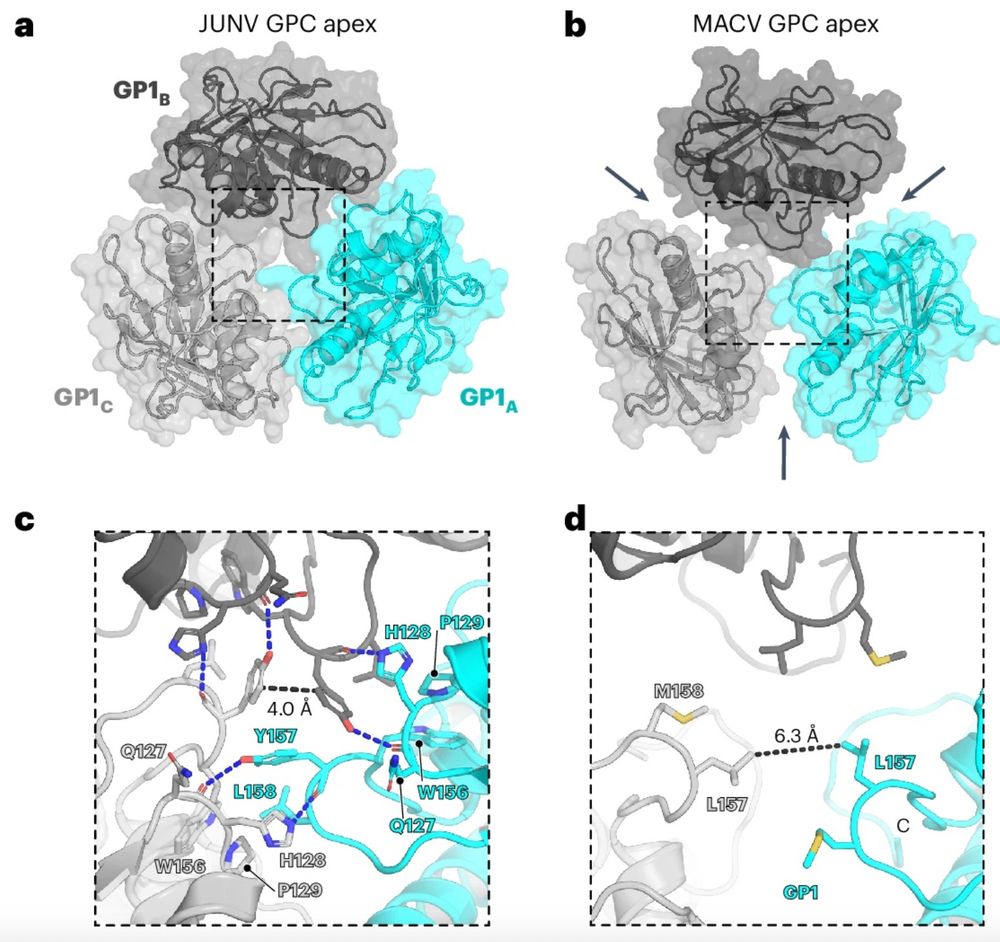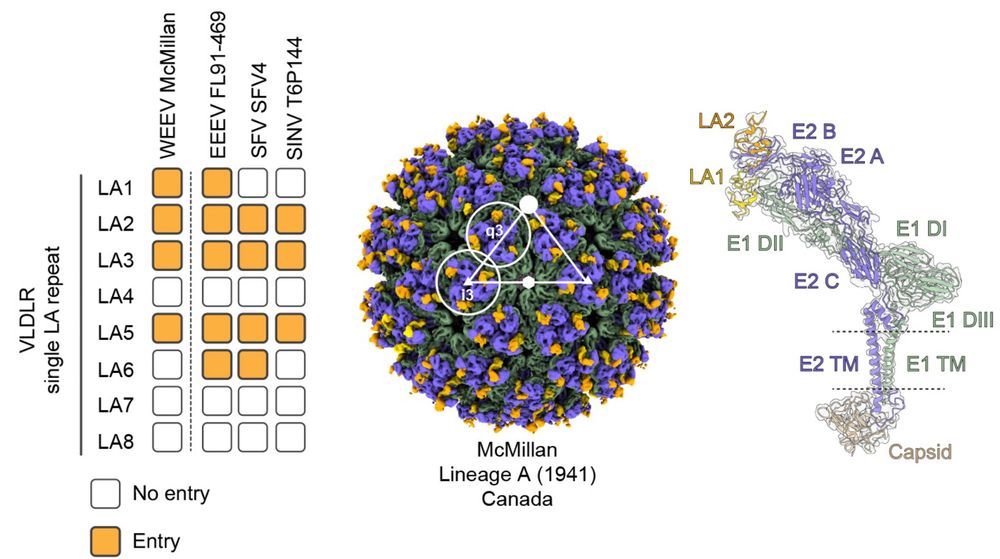Though the Candid#1 vaccine is effective against JUNV, other lethal New World arenaviruses still pose a large public health risk 🌎with no specific medical countermeasures. The structures may serve as a basis for further rational design and development of therapeutics and vaccines
09.08.2025 09:51 — 👍 1 🔁 0 💬 0 📌 0

A K33A substitution in the stable signal peptide (SSP) allowed for stabilization of the pre-fusion GPC, with molecular dynamics suggesting K33A stabilizes GPC by better accommodating membrane lipids in the SSP33 pocket, supported by our cryo-EM density
09.08.2025 09:51 — 👍 0 🔁 0 💬 1 📌 0

Further structural and functional analyses also reveal the effect of specific residues in transmembrane and membrane proximal region on pH-mediated fusion, elucidating the attenuation mechanism of the JUNV Candid#1 vaccine
09.08.2025 09:51 — 👍 0 🔁 0 💬 1 📌 0

These cryo-EM structures reveal notable differences between JUNV and MACV in GP1 organization at the apex and C terminus. The MACV GPC apex has a more open appearance due to its GP1 subunits slightly rotating outwards and clockwise 🔃compared to JUNV GP1 subunits
09.08.2025 09:51 — 👍 0 🔁 0 💬 1 📌 0

Our @natmicrobiol.nature.com paper provides the most complete insight into the molecular organization of the JUNV and MACV GPCs yet 😲revealing new features not seen in previous structures, such as the TM helices and cytosolic portions, including ZBD
09.08.2025 09:51 — 👍 0 🔁 0 💬 1 📌 0
New World arenaviruses, like Junin virus (JUNV) and Machupo virus (MACV), cause hemorrhagic fever with fatality rates as high as 30% predominantly in South America. To date, the only medical countermeasure against these viruses is the Candid#1 vaccine effective only against JUNV
09.08.2025 09:51 — 👍 0 🔁 0 💬 1 📌 0
WEEV re-emerged in South America in 2023-2024 in a large outbreak, highlighting the critical need for preparedness. Using the structures, we identified E2 polymorphisms that predict WEEV strain receptor dependency, which will support environmental surveillance.
04.04.2025 19:58 — 👍 3 🔁 0 💬 0 📌 0

Interesting tidbit in the story: a WEEV-related alphavirus that circulates on the east coast (EEEV territory) called highlands J virus (HJV) also uses PCDH10 as a receptor. It diverged from WEEV not that long ago and retained most PCDH10 contact residues.
04.04.2025 19:58 — 👍 5 🔁 1 💬 1 📌 0

Some WEEV strains and EEEV both bind VLDLR at the LA1 and LA2 domains, suggesting that VLDLR LA1-LA2 decoy receptor may have broad activity against them. This molecule protected mice against lethal challenge by a WEEV strain that binds VLDLR.
04.04.2025 19:58 — 👍 1 🔁 0 💬 1 📌 0

Strains isolated during epidemics of the early 20th century bind VLDLR and ApoER2 as additional receptors. Our structure of a 1941 strain bound by VLDLR revealed a distinct binding mode than other alphaviruses that bind LDLR-related proteins, such as EEEV, SFV or VEEV.
04.04.2025 19:58 — 👍 0 🔁 0 💬 1 📌 0

We found a substitution in the E2 glycoprotein, L149Q, that would disrupt hydrophobic contact with PCDH10, and confirmed this mutation alone abolishes human PCDH10 binding. L149Q is found in all strains isolated in California and Texas in 2005, suggesting a wide geographic range.
04.04.2025 19:58 — 👍 1 🔁 0 💬 1 📌 0

Protocadherin 10 (PCDH10) is a major receptor for WEEV. Multiple strains isolated in 2005 lost the ability to bind human and horse PCDH10, yet still bind avian PCDH10. Cryo-EM structures show identical binding mode of sparrow and human PCDH10.
04.04.2025 19:58 — 👍 1 🔁 0 💬 1 📌 0
WEEV is a mosquito-borne alphavirus that caused widespread outbreaks in horses and humans in the early 20th century, but outbreak frequency and scale dramatically decreased since then. We previously found this “submergence” of WEEV was accompanied by shifted receptor recognition.🦟🐎
04.04.2025 19:58 — 👍 1 🔁 0 💬 1 📌 0
Thank you to everyone who contributed, including @wanyuviridae.bsky.social, @jessicaoros.bsky.social, @hhvarnum.bsky.social, and everyone else!
02.01.2025 22:25 — 👍 1 🔁 0 💬 0 📌 0
WEEV is not gone, as a 2023-24 South American outbreak caused >2500 horse and >200 human cases. Therefore, this information is critical to estimate the potential threat of any new WEEV strain, supporting environmental surveillance and outbreak preparedness @hhmi.bsky.social
02.01.2025 22:25 — 👍 1 🔁 0 💬 1 📌 0

We also determined structures of an ancestral WEEV strain bound to VLDLR, revealing a distinct binding mode compared to other alphaviruses that bind LDLR-related receptors such as EEEV, SFV, or VEEV, indicating independent evolution of WEEV to bind VLDLR/ApoER2!
02.01.2025 22:25 — 👍 1 🔁 0 💬 1 📌 0
To explain why recent WEEV strains such as 2005 Imperial 181 lost human PCDH10 binding, we identified a single amino acid change in the E2 glycoprotein (Q149), which disrupts ❌key hydrophobic contacts present in ancestral strains containing a conserved L149.
02.01.2025 22:25 — 👍 1 🔁 0 💬 1 📌 0
Our new study defines WEEV amino acid polymorphisms that explain shifts in receptor usage. By using cryo-EM, we showed that PCDH10 binds the clefts between adjacent WEEV E2–E1 glycoprotein heterodimers, mimicking the binding mode of PCDH10 antiparallel homodimers.
02.01.2025 22:25 — 👍 1 🔁 0 💬 1 📌 0

Shifts in receptors during submergence of an encephalitic arbovirus - Nature
Knockout studies using CRISPR–Cas9 identify PCDH10 as a selective host cellular receptor for western equine encephalitis virus.
In our recent paper @nature, we identified the protocadherin PCDH10 as a receptor for WEEV and found that WEEV appears to have shifted away from using human and horse PCDH10, correlating to the decline in outbreaks ⤵️ www.nature.com/articles/s41...
02.01.2025 22:25 — 👍 1 🔁 0 💬 1 📌 0
Transmitted by mosquitoes 🦟 to humans and horses, western equine encephalitis virus (WEEV) has caused several outbreaks throughout the 20th century, but decreases in outbreak frequency and scale indicate a submergence of WEEV.
02.01.2025 22:25 — 👍 1 🔁 0 💬 1 📌 0

Excited to share our @biorxivpreprint.bsky.social exploring how binding of western equine encephalitis virus (WEEV) to its cellular receptors evolved over the past century 🤩 www.biorxiv.org/content/10.1... @harvardmicro.bsky.social
02.01.2025 22:25 — 👍 6 🔁 3 💬 1 📌 0
Dr. Michael Letko’s Laboratory of Functional Viromics | we study zoonotic potential of novel viruses.
For more information, check out our website: https://labs.wsu.edu/lofv/
Purveyor of the Virosphere.
Professor Earth, Ocean & Atmospheric Sciences, Microbiology & Immunology, Botany, and the Inst for the Oceans & Fisheries - UBC
https://www.eoas.ubc.ca/people/curtissuttle
Associate Professor of Political Science at Tulane University. Mujer. Argentina. Y algunas cosas más.
Author of Patronage at Work: https://bit.ly/344DWyU
The ISV is a global not-for-profit organization that aims to encourage, establish, and promote the development and use of vaccines to prevent and control infectious and non-infectious diseases in animals and humans.
A project by the College of Physicians of Philadelphia, documenting the history and science of vaccination from before Jenner and after mRNA.
epiren.bsky.social <- Editor
@HistoryVaccines <- Elsewhere
Assistant Professor of Biochemistry | Case Western Reserve University | Viruses, RBPs, innate immunity and RNA tech | Views my own | 🇺🇸🇲🇽 | Lab website: lunalab.org
Wir sind die Fachgesellschaft für Ärzt/Innen und Wissenschaftler/Innen aus dem Bereich der Virologie in und aus Deutschland, Österreich und der Schweiz
https://g-f-v.org/
Clinical virologist, departement of virology, The Norwegian Institute of Public Health
Virologist🦠🦇🐀🦟Assoc. Prof. @UTMBHEALTH Galveston National Lab-Bench/Field Study of Viral Hemorrhagic Fevers & Emerging Viral Diseases-All opinions are mine
https://www.utmb.edu/microbiology/faculty/robert-cross
Virologist @ AFBI | influenza viruses | surveillance | vaccines | Belfast, Northern Ireland
Associate Professor of Microbiology & Immunology
UNC Chapel Hill
Viral pathogenesis, arboviruses, virus-host interactions, antiviral immunity
www.lazearlab.org
Asst Prof/PI @ The Ohainle Lab @ohainlelab.bsky.social
UC Berkeley MCB
www.theohainlelab.com
viruses and how cells restrict them
Editor-in-Chief of a very good microbial journal.
(Illustration by David S. Goodsell, RCSB Protein Data Bank. doi: 10.2210/rcsb_pdb/goodsell-gallery-028)
Professor of viral immunity at Cambridge Uni, Dept of Pathology. Mainly poxviruses and innate immunity. www.fergusonlab.path.cam.ac.uk
Virologist. Evolutionary biologist.
Virologist | Microbe Enthusiast | Book lover | WOSO enthusiast | This a personal account.
Vice President - National Microbiology Laboratory Branch, PHAC; Associate Professor, Canada Research Chair in emerging viruses, U.Manitoba. Expert in the emerging zoonotic viruses with a focus on WHO priority pathogens. All views expressed are my own
Ph.D. and molecular virologist, studying metabolic drivers of sex differences in viral immunity. Currently, a Postdoc in Sabra Klein lab @ Johns Hopkins. Pronouns: she/hers. Failure: Own it, but don't let it eat you, let it teach you.















